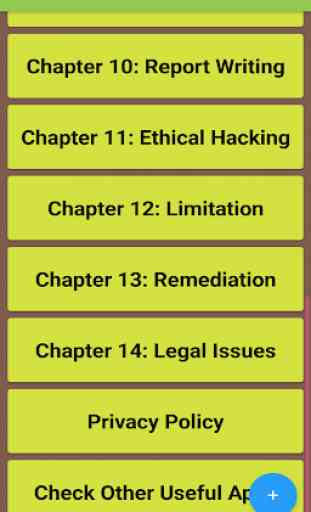Learn Penetration Testing
Here's a more detailed breakdown of the course content:
1. Information Gathering - In this section you'll learn how to gather information about a target website, you'll learn how to discover the DNS server used, the services, subdomains, un-published directories, sensitive files, user emails, websites on the same server and even the web hosting provider. This information is crucial as it increases the chances of being able to successfully gain access to the target website.
2. Discovering, Exploiting & Mitigation - In this section you will learn how to discover, exploit and mitigate a large number of vulnerabilities, this section is divided into a number of sub-sections, each covering a specific vulnerability, firstly you will learn what is that vulnerability and what does it allow us to do, then you will learn how to exploit this vulnerability and bypass security measurements, and finally we will analyse the code causing this vulnerability and see how to fix it, the following vulnerabilities are covered in the course:
File upload : This vulnerability allow attackers to upload executable files on the target web server, exploiting these vulnerabilities properly gives you full control over the target website.
Code Execution - This vulnerability allow users to run system code on the target web server, this can be used to execute malicious code and get a reverse shell access which gives the attacker full control over the target web server.
Local File inclusion - This vulnerability can be used to read any file on the target server, so it can be exploited to read sensitive files, we will not stop at that though, you will learn two methods to escalate this vulnerability and get a reverse shell connection which gives you full control over the target web server.
Remote File inclusion - This vulnerability can be load remote files on the target web server, exploiting this vulnerability properly gives you full control over the target web server.
SQL Injection- This is one of the most dangerous vulnerabilities, it is found everywhere and can be exploited to do all of the things the above vulnerabilities allow us to do and more, so it allows you to login as admin without knowing the password, access the database and get all data stored there such as usernames, passwords, credit cards ....etc, read/write files and even get a reverse shell access which gives you full control over the target server!
Cross Site Scripting (XSS) - This vulnerability can be used to run javascript code on users who access the vulnerable page, we won't stop at that, you will learn how to steal credentials from users (such as facebook or youtube passwords) and even gain full access to their computer. You will learn all three types (reflected, stored and DOM-based).
Insecure Session Management - In this section you will learn how to exploit insecure session management in web applications and login to other user accounts without knowing their password, you'll also learn how to discover and exploit CSRF (Cross Site Request Forgery) vulnerabilities.
Brute Force & Dictionary Attacks - In this section you will learn what are these attacks, what is the difference between them and how to launch them, in successful cases you will be able to guess the password for a target login page.
3. Post Exploitation - In this section you will learn what can you do with the access you gained from exploiting the above vulnerabilities, you will learn how to convert reverse shell access to a Weevely access and vice versa, you will also learn how to execute system commands on the target server, navigate between directories, access other websites on the same server, upload/download files, access the database and even download the whole database to your local machine. You will also learn how to bypass security and do all of that even if you did not have enough permissions
1. Information Gathering - In this section you'll learn how to gather information about a target website, you'll learn how to discover the DNS server used, the services, subdomains, un-published directories, sensitive files, user emails, websites on the same server and even the web hosting provider. This information is crucial as it increases the chances of being able to successfully gain access to the target website.
2. Discovering, Exploiting & Mitigation - In this section you will learn how to discover, exploit and mitigate a large number of vulnerabilities, this section is divided into a number of sub-sections, each covering a specific vulnerability, firstly you will learn what is that vulnerability and what does it allow us to do, then you will learn how to exploit this vulnerability and bypass security measurements, and finally we will analyse the code causing this vulnerability and see how to fix it, the following vulnerabilities are covered in the course:
File upload : This vulnerability allow attackers to upload executable files on the target web server, exploiting these vulnerabilities properly gives you full control over the target website.
Code Execution - This vulnerability allow users to run system code on the target web server, this can be used to execute malicious code and get a reverse shell access which gives the attacker full control over the target web server.
Local File inclusion - This vulnerability can be used to read any file on the target server, so it can be exploited to read sensitive files, we will not stop at that though, you will learn two methods to escalate this vulnerability and get a reverse shell connection which gives you full control over the target web server.
Remote File inclusion - This vulnerability can be load remote files on the target web server, exploiting this vulnerability properly gives you full control over the target web server.
SQL Injection- This is one of the most dangerous vulnerabilities, it is found everywhere and can be exploited to do all of the things the above vulnerabilities allow us to do and more, so it allows you to login as admin without knowing the password, access the database and get all data stored there such as usernames, passwords, credit cards ....etc, read/write files and even get a reverse shell access which gives you full control over the target server!
Cross Site Scripting (XSS) - This vulnerability can be used to run javascript code on users who access the vulnerable page, we won't stop at that, you will learn how to steal credentials from users (such as facebook or youtube passwords) and even gain full access to their computer. You will learn all three types (reflected, stored and DOM-based).
Insecure Session Management - In this section you will learn how to exploit insecure session management in web applications and login to other user accounts without knowing their password, you'll also learn how to discover and exploit CSRF (Cross Site Request Forgery) vulnerabilities.
Brute Force & Dictionary Attacks - In this section you will learn what are these attacks, what is the difference between them and how to launch them, in successful cases you will be able to guess the password for a target login page.
3. Post Exploitation - In this section you will learn what can you do with the access you gained from exploiting the above vulnerabilities, you will learn how to convert reverse shell access to a Weevely access and vice versa, you will also learn how to execute system commands on the target server, navigate between directories, access other websites on the same server, upload/download files, access the database and even download the whole database to your local machine. You will also learn how to bypass security and do all of that even if you did not have enough permissions
Category : Education

Related searches
Reviews (2)
A. G. u.
Mar 8, 2020
Best





very basic details.. u should add basic before the name... or intro to pen testing in app name...